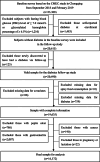Consuming spicy food and type 2 diabetes incidence in Southwestern Chinese aged 30-79: a prospective cohort study
- PMID: 39523341
- PMCID: PMC11552132
- DOI: 10.1186/s12937-024-00996-4
Consuming spicy food and type 2 diabetes incidence in Southwestern Chinese aged 30-79: a prospective cohort study
Abstract
Background: Capsaicin is the main component of chili peppers and is believed to have antidiabetic effects. However, the association between spicy food consumption and the incidence of diabetes remains unclear.
Methods: A cohort of 20,490 Han residents aged 30-79 without diabetes at baseline were followed from enrollment to June 2, 2023. The consumption of spicy food was obtained through face-to-face surveys conducted during the baseline survey from October 2018 to February 2019. The definition of type 2 diabetes onset was based on the ICD-10 code of E11 in the diabetes case reporting system and death system; Additionally, self-reported diagnosis of diabetes by a physician in active follow-ups, or a fasting blood glucose level of ≥ 7 mmol/L or a glycated hemoglobin percentage of ≥ 6.5% found on-site during the resurvey. Both Cox proportional hazard regression and competing risk regression were used to calculate hazard ratios (HRs) and confidence intervals (CIs).
Results: During the follow-up period (53.5 ± 3.0 months), 182 individuals (1.1%) were newly diagnosed with T2D with an incidence rate of 246.2 per 100,000 person-years. Cox regression analyses revealed that spicy food consumers had a 34% reduced risk of developing type 2 diabetes (HR: 0.66, 95% CI: 0.48, 0.91) compared to non-consumers. The HRs (95% CIs) for participants consuming spicy food 3-5 days/week, 6-7 days/week, and with weak pungency were 0.45 (95% CI: 0.25, 0.81), 0.69 (0.49, 0.98), and 0.64 (0.46, 0.90), respectively. However, little significant protective effect was observed among those who consumed spicy food for 1-2 days/week, with moderate pungency, or with strong pungency (all P > 0.05).
Conclusions: Consuming spicy food may lower the risk of developing type 2 diabetes, particularly at a frequency of 3-5 days/week, and with weak pungency. Further multicenter prospective studies or interventional studies are needed to confirm these findings.
Keywords: China multi-ethnic cohort; Cohort study; Epidemiology; Spicy food; Type 2 diabetes.
© 2024. The Author(s).
Conflict of interest statement
Figures


Similar articles
-
Association between spicy food and hypertension among Han Chinese aged 30-79 years in Sichuan Basin: a population-based cross-sectional study.BMC Public Health. 2023 Aug 30;23(1):1663. doi: 10.1186/s12889-023-16588-6. BMC Public Health. 2023. PMID: 37649009 Free PMC article.
-
[Spicy food consumption and risk of lip, oral cavity and pharynx cancers: a prospective cohort study of Chinese adults].Zhonghua Liu Xing Bing Xue Za Zhi. 2022 Feb 10;43(2):169-174. doi: 10.3760/cma.j.cn112338-20210616-00475. Zhonghua Liu Xing Bing Xue Za Zhi. 2022. PMID: 35184480 Chinese.
-
Sex-dependent difference in the association between frequency of spicy food consumption and risk of hypertension in Chinese adults.Eur J Nutr. 2019 Sep;58(6):2449-2461. doi: 10.1007/s00394-018-1797-8. Epub 2018 Aug 4. Eur J Nutr. 2019. PMID: 30078091
-
Development of type 2 diabetes mellitus in people with intermediate hyperglycaemia.Cochrane Database Syst Rev. 2018 Oct 29;10(10):CD012661. doi: 10.1002/14651858.CD012661.pub2. Cochrane Database Syst Rev. 2018. PMID: 30371961 Free PMC article.
-
Association of Spicy Chilli Food Consumption With Cardiovascular and All-Cause Mortality: A Meta-Analysis of Prospective Cohort Studies.Angiology. 2021 Aug;72(7):625-632. doi: 10.1177/0003319721995666. Epub 2021 Mar 4. Angiology. 2021. PMID: 33657876
References
-
- International Diabetes Federation. Diabetes Atlas, 10th edition. Brussels, Belgium 2021.
-
- Papamichou D, Panagiotakos DB, Itsiopoulos C. Dietary patterns and management of type 2 diabetes: a systematic review of randomised clinical trials. Nutr Metabolism Cardiovasc Diseases: NMCD. 2019;29(6):531–43. 10.1016/j.numecd.2019.02.004. - PubMed
MeSH terms
Grants and funding
LinkOut - more resources
Full Text Sources
Medical

